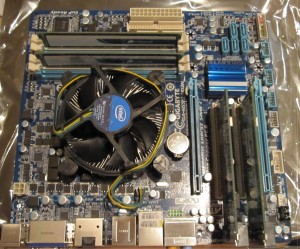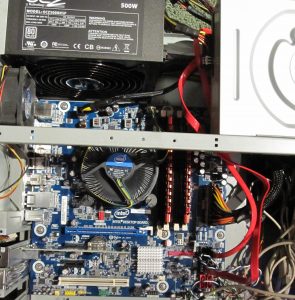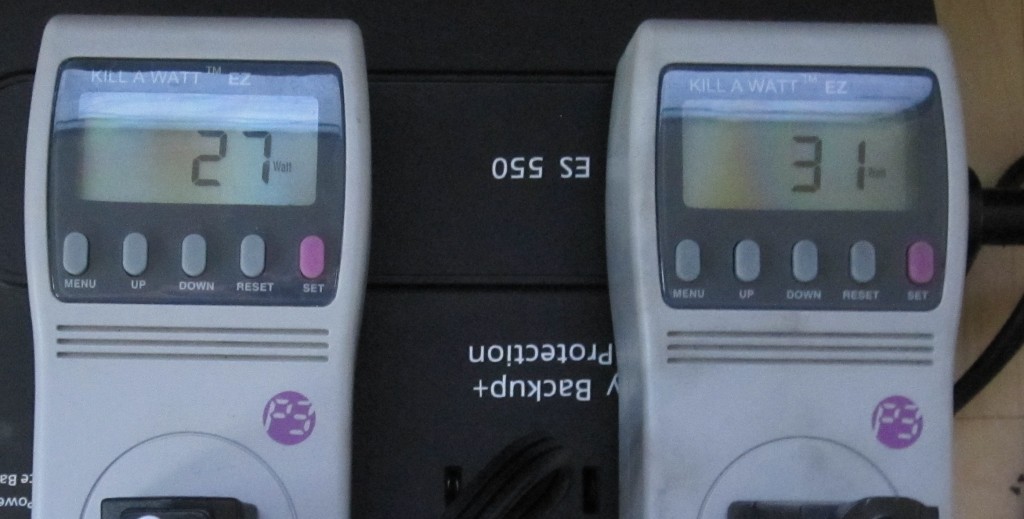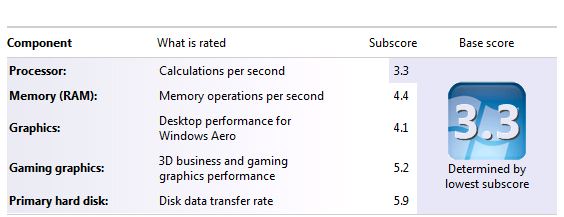Intel’s Clarkdale and H55/ H57 platforms are quite intriguing for several reasons. First, the performance is fairly good starting at 2.93ghz, and with hyperthreading, it is possible to get closer to a quad core performance in some tasks where multiple cores do well, such as video encoding. A second aspect is that Intel moved the IGP to an on package solution and really cut the power consumption/ heat dissipation of the platform. Finally, the cost of an i3-530 or i5-650 CPU plus a motherboard is often in the $200 or less range, making them quite affordable.
Two great uses for the chips are home servers and HTPC’s. Low power consumption and low heat generation ultimately enable lower acoustic signatures, as well as lower TCO through lower electric draw.

Soon after getting the i3 and i5 setups, I started making some interesting observations. First, I noticed that enabling energy saving features caused my 850w PSU to shut down, however by disabling the energy saving features, and increasing the electric load slightly by installing add-in cards, the issue disappeared. Next, I noticed that the stock Intel cooler was low profile, and quiet. For those accustomed to the 45nm LGA-1366 Xeons/ Core i7’s and chips such as the Q6600, the retail HSF is miniscule. Interestingly enough, I also saw idle temperatures of 30C in a 20C ambient room with the stock heatsink, so it became clear that the cooler was working.

I soon realized the only fan my system needed (with the PicoPSU) was the stock Intel fan. This contrasted to my Asus platform that had an Atom N330 chip with NVIDIA’s ION chipset that had the CPU/GPU heatsink removed, but retained the 250w power supply’s heatsink (I cannot run completely passive in the California heat).
As part of just about every review on the web, both the ION and the Intel 2010 core lineup of i3’s and i5’s are capable of playing blu-ray video. For a HTPC, these are obvious choices because they require a single fan and can play content. The question for me though, which made the better streaming box?
My criteria are:
- Must be fast enough to playback full screen HD video at 1080 resolution
- Must be silent in a closed case
- Must consume low idle power since the boxes will be on 24/7
- Must be 64-bit capable and have the ability to add an Intel NIC.
For my HTPC builds I use Windows 7 x64 (usually ultimate), 4GB of ram, a SSD (solely for the lack of noise/ vibration). I also prefer to add an Intel Gigabit network card, if the board does not have onboard Intel GigE. I have found time and time again that the Intel NICs are plug-and-play solutions for streaming video over gigabit ethernet without the occasional stutter that makes viewing a poor experience over Realtek solutions that I have seen.
Here’s some data points. First, Kill-A-Watt power consumption using two Kill-A-Watts (of eight purchased) that display 60w and 90w correctly for light bulbs. While this is not super accurate, it is the best that can be done cheaply and easily.

This was a shock to me. The i5-650 registered lower power consumption than the Intel Atom N330/ NVIDIA ION Platform. For HTPC’s/ media players and Windows Home Server boxes, idle power consumption is very important. The Atom is an 8w TDP part, while the i5-650 is a 73w TDP part. With that being said, it appears as though the newer 32nm process, and more aggressive power consumption features make the i5-650 competitive at idle. Under load, the i3-530 and i5-650 seems to draw 50w more while the Atom draws approximately 4-5w more than at idle.
Performance wise, it gets more interesting:


Needless to say, this was shocking, even if it isn’t the best benchmark. Graphics performance ended up close under WEI and CPU performance was dominated by the stock clocked i5-650. Since gaming is more or less out of the question given the integrated GPU, I thought this was quite interesting given the i5-650 is a lower power solution. That being said, the Clarkdale i5’s are 2010 solutions while the N330 was released in September 2008. A quick glance at the spec sheets shows that both CPU’s can handle Hyperthreading and 64-bit instruction sets, the Core i5-650 supports virtualization (VT-x and VT–d), AES-NI, and etc. With the increased requirements Windows Home Server version 2 (WHSv2 or Vail) will bring due to being based on Windows Server 2008 R2, it seems as though the Atom would not be the best WHS choice at the moment.




wow pretty cool. i guess the new fab is awesome. tried virtualization on the clarkdale yet?
The question is, since Intel does not have H55\57 drivers for Server 2003 (Home Server), will these boards actualy work with MS Home Server?
I was able to get them to work using the Windows XP drivers (since that is very similar to Server 2003). Vail will be based on Windows Server 2008 R2, which I have running on an i3 H55 system. I also tried running WHS in a Hyper-V VM on the Windows Server 2008 R2 and that worked OK even on the i3-530 with the Intel H55 board.
Thanks for the info!
I’ve got a WHS running on a ASUS H55 mobo with an i3-530. Included (or downloaded from ASUS web site) Intel Chipset, SATA & VGA XP drivers work fine.
Which PSU is used for the Core i5 at the “Kill-a-watt” shot?
It was using a PicoPSU 150 XT with a 150w power adapter. Using larger (400w+) conventional power supplies with that platform resulted in significantly more power consumption.
Anandtech has measured the i5-650 idle at 73 watts. Where could such a big difference come from?
http://www.anandtech.com/show/2972/the-rest-of-clarkdale-intel-s-pentium-g6950-core-i5-650-660-670-reviewed/8
Anand does not use integrated video for power consumption comparisons.
His test rig (page 2 of that review… at the very bottom) says he used a eVGA GTX 280. Since both the Atom/ ION and the Clarkdale use an integrated GPU and most of my readers use their PC’s for HTPC’s or home servers, I decided to use what comes stock. Anand’s test methodology is reasonable for anantech since they test lots of CPU’s and chipsets where there are no integrated graphics available (i.e. Intel X58, P55 and etc.) When you get away from doing gaming, you can save a few hundered on a GPU and 40w+ pretty easily.
Plus, he used a ASUS P7H57DV- EVO which is a H57 full ATX board with USB 3.0 and SATA 3.0 that costs $200+. Not exactly the type of board you would use in a HTPC or a home server (since for a server a Supermicro X8SIL-F would be 50x better). ATX boards also tend to use more power, especially when they have extra controllers for SATA 3.0 and USB 3.0. There’s a huge difference between gaming PC power consumption and non-gaming PC power consumption at this point. The PicoPSU couldn’t even power his test rig.
Allright, thanks a lot.
And how many watts do you think you can shave off by using a 150w pico psu instead of using something like a Corsair 400w psu?
So here is the interesting thing. At 27w of power draw, 20% inefficiency is only adding ~5.4w of draw. The big reasons to use a PicoPSU in my mind are:
1. You want a silent PC
2. You are aiming for the lowest power consumption possible
3. You need a smaller form factor.
I think my setup was around $90 with tax and shipping. When the Antec TruePower 1,000w Quattros that I use go on sale at Fry’s they are $120 for comparison.
If you saved 15w I would think that would be pretty amazing. In my area, using non-TOU differentiated rates, 15w running 24×7 for a year is only $17. So it is hard to justify spending $90 on a PSU to save $17 a year versus a Corsair 400w power supply at $40 (after rebate)
Hi Patrick,
I’m trying to decide between an i3-530 and an i5-650. The i5-650 is of course a bit faster… I know for sure that both CPUs use very little power when idle (thanks for posting the KillAWatt rating of the i5-650, by the way), but I haven’t really seen a comparison of the power consumption of both CPUs on the same hardware when hooked up to a KillAWatt.
Was curious if you noticed a difference between load/idle power consumption between the i3-530 and i5-650?
Hi other Patrick. Great name!
The difference is 1-2w at idle when using a PicoPSU on a KillAWatt. It was close enough I didn’t see a point in posting i3-530 numbers. Load numbers the i5-650 is probably 2-4w higher. Those figures are a bit harder due to the on-package GPU.
One thing to *consider* is a X3430 in this price range if you are doing a lot more with the machine and are going to use a server class motherboard with onbaord video. Using a Supermicro X8SIL-F which is a server motherboard with a baseboard management subsystem, the i3-530 pulled 40w at idle and the X3440 pulled 48w. You can follow this link to see the i3-530 and X3440 on Supermicro X8SIL-F idle power consumption Kill-A-Watt shots. The i3-530 numbers in that post are not comparable to these numbers because the Supermicro board draws more idle power.
Hi there,
Do you have the power consumption of N330 using your test bed at full load or, maybe watching a movie. I would like to buy ZOTAC IONITX-G-E board, and i have 100 watt psu that came with my case (Shuttle KP-10). I was wondering if this PSU would work. I want to use it for my home brewed file server.
Take care,
Kabel
Hi Kabel, I responded to your other comment in the Atom D510 versus N330 article. That PSU will work assuming you do not have lots of drives hooked up. Three or possibly four drives would be the limit, but I would suggest using two or less with a 100w PSU because running lower-cost PSUs at high load tends to have a negative impact on stability and longevity.
Patrick, on your comment on March 16th you post about installing W2008R2 on an i3 H55 system.
Have you installed XP Intel display drivers? and are ok?
I have tried to install Intel XP drivers and Intel Win7 drivers with no look.
Win XP drivers do not install, and Win7(x64) drivers produce display corruption at startup.
I am using the integrated display card on the mobo.
Any advice? Which drivers version have you installed?
Thanks
Assessing the accuracy of a Kill-A-Watt by comparing its reading with the nominal wattage of a lightbulb is an extremely inaccurate option. With any multimeter you can get at least 100-fold more accurate just as cheaply and easily by measuring the voltage applied and the current that flows, and then multiplying the two measured values to get the power consumption with at least 0.1 watt precision. Just be sure to measure the current in series with your PC or your lightbulb, otherwise your fuses and circuit breakers will go POOFFF!!! Or worse…
I’ve got an older zotac itx running an E3300 and onboard nvidia 7050.
It gets Procoessor 5.9, mem 5.5, graph 3.4, game 3.2, hard drive 5.8.
I don’t have the means to measure power consumption…. but it barely puts any heat out (on 24/7).
I’d like to find out how a zotac 9300 (e3300, or e7200 or better) would compare to an intel h55…. power consumption and performance (can’t seem to find a comparison on the internet). I have no interest in the Atom…. and the SU at 1.2 duo core is still to slow (especially compared to an I core).
Wayne: I will see what I can do. It is a bit expensive to buy LGA 775 for what you get at this point though. The Core i3 and i5 with integrated GPUs are a process node more advanced than the LGA 775 CPUs and the 9300 plus you use DDR3 which runs at 1.5-1.6v these days which combine for a sizable advantage.
Just my 2 cents, if anyone is looking to get similar results. I have a asus motherboard P7Q57-M DO, 64gb SSD, 8g memory, 400 watt gold seasonic PSU. I averaged 40 watts. With all cables off (network, video, mouse) I got 38 watts. Kind of disappointing but I will be adding 4 more drives and VM’s.
I forgot to add that i also have a intel i5 650
Hi,
Thanks for the review…
Firstly the ION power consumption figures look high but in all fairness it’s down to the efficiency of your PSU.
When I got the IONITX-P-E(the more powerful su2300 cpu) earlier this week and plugging in a standard PSU, idle stood at 39W which made me worry. Yesterday my 120W pico PSU + 60W brick arrived and idle is now 20W \o/
However one thing I do need to ask you is whether there is any difference in consumption at idle with monitor power saving on. For some reason the ION can’t turn off/power save the monitor in my system which I find very strange.
Many thanks
Got rid of my PS3 as a media/netflix center after reading… http://www.energy.gs/2008/11/how-much-energy-does-sony-ps3-use.html
Now I have a Foxconn 330 Atom 330 Nvidia ION 2b RAM 300GB HD for my Netflix/Hi-Def material.
Game rig is i5-650 and 9800 GX2 (which was bottlekneck by a core 2 duo e7200 til last week).
Consoles are bad for the environment :P